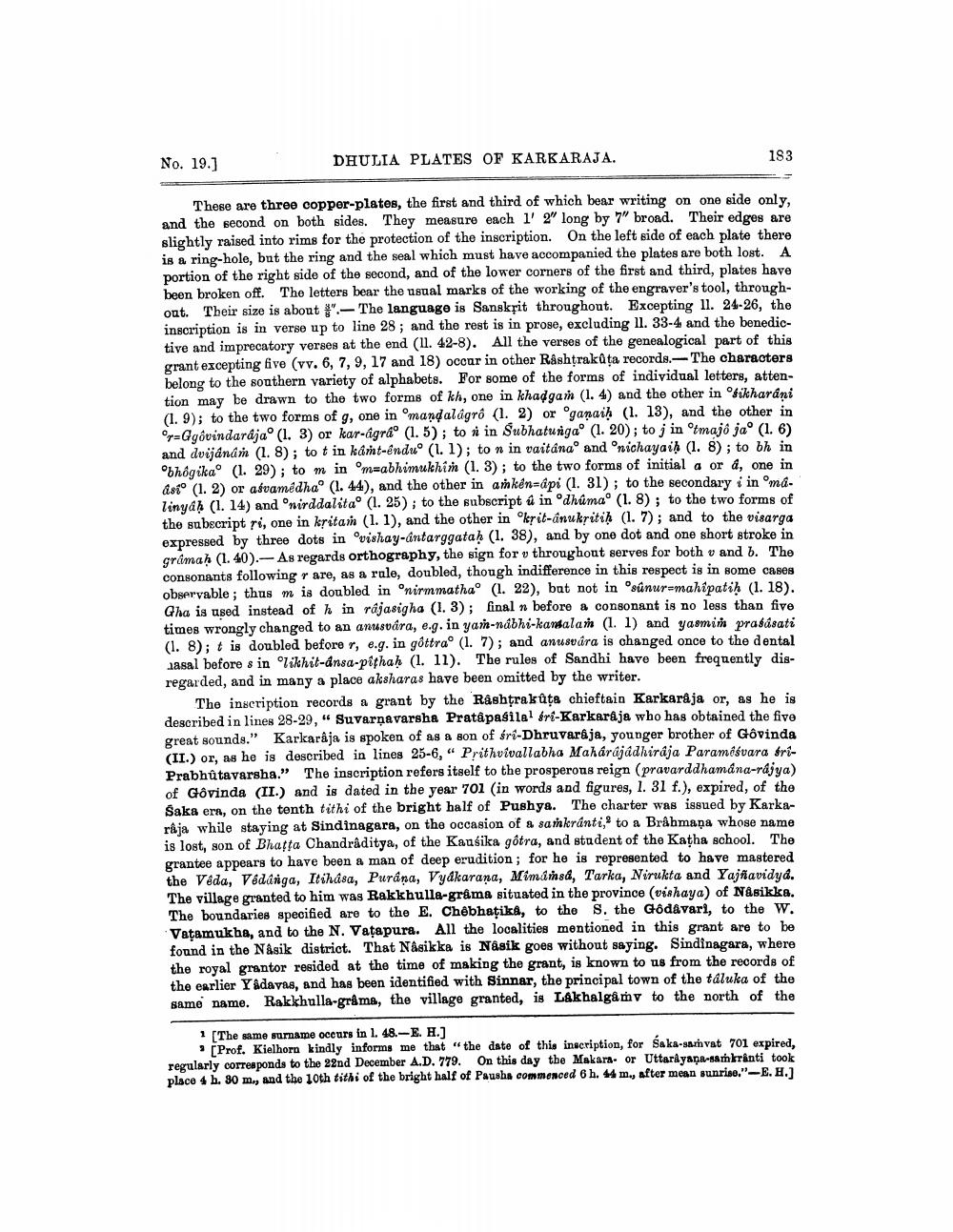________________
No. 19.]
DHULIA PLATES OF KARKARAJA.
183
These are three copper-plates, the first and third of which bear writing on one side only, and the second on both sides. They measure each l' 2" long by 7" broad. Their edges are slightly raised into rims for the protection of the inscription. On the left side of each plate there is a ring-hole, but the ring and the seal which must have accompanied the plates are both lost. A portion of the right side of the second, and of the lower corners of the first and third, plates have been broken off. The letters bear the usual marks of the working of the engraver's tool, throughout. Their size is about $" -The language is Sanskrit throughout. Excepting ll. 24-26, the inscription is in verse up to line 28; and the rest is in prose, excluding ll. 33-4 and the benedictive and imprecatory verses at the end (11. 42-8). All the verses of the genealogical part of this grant excepting five (vv. 6, 7, 9, 17 and 18) occur in other Rashtrakūta records. The characters belong to the southern variety of alphabets. For some of the forms of individual letters, attention may be drawn to the two forms of kh, one in khadga (1. 4) and the other in fikharani (1.9); to the two forms of g, one in mandalagrô (1.2) or Oganaih (1. 13), and the other in or=Ggovindarajao (1. 3) or kar-agrão (1.5); to i in Subhatungao (1. 20); to j in otmajo jao (1.6) and dvijánán (1. 8); to t in kant-enduo (1.1); to n in vaitánao and Onichayai) (1. 8); to bh in
bhôgikao (1. 29); to m in m=abhimukhin (1.3); to the two forms of initial a or d, one in asio (1.2) or asvamédha' (1. 44), and the other in ankén=api (1. 31); to the secondary i in malinya” (1. 14) and rirddalitao (1.25); to the subscript i in odhúmao (1.8); to the two forms of the subscript şi, one in kritam (1.1), and the other in oksit-anukritih (1.7); and to the visarga expressed by three dots in vishay-ántarggataḥ (1. 38), and by one dot and one short stroke in gramah (1.40).-As regards orthography, the sign for v throughout serves for both v and b. The consonants following r are, as a rale, doubled, though indifference in this respect is in some cases observable; thus m is doubled in onirmmathao (1. 22), but not in osúnur=mahipatih (1. 18). Cha is used instead of h in rajasigha (1.3); final n before a consonant is no less than five times wrongly changed to an anusvára, e.g. in yan-nabhi-kanaalam (1.1) and yasmin prasásati (1. 8); t is doubled before r, e.g. in gôttrao (1. 7); and anusuára is changed once to the dental jasal before s in likhit-ansa-pithah (1. 11). The rules of Sandhi have been frequently disregarded, and in many a place aksharas have been omitted by the writer.
The inscription records a grant by the Rashtrakûts chieftain Karkara ja or, as he is described in lines 28-29, “ Suvarnavarsha Pratâpasilal bri-Karkaraja who has obtained the five great sounds." Karkaraja is spoken of as a son of śri-Dhruvardja, younger brother of Gôvinda (II.) or, as he is described in lines 25-6,“ Prithvivallabha Maharajadhiraja Paramosvara friPrabhůtavarsha." The inscription refers itself to the prosperous reign (pravarddhamana-rajya) of Govinda (II.) and is dated in the year 701 (in words and figures, 1. 31 f.), expired, of the Saka era, on the tenth tithi of the bright half of Pushya. The charter was issued by Karkarâja while staying at Sindinagara, on the occasion of a sankranti, to a Brahmaṇa whose name is lost, son of Bhatta Chandråditya, of the Kausika gôtra, and student of the Katha school. The grantee appears to have been a man of deep erudition ; for he is represented to have mastered the Veda, Veduriga, Itihasa, Purana, Vyakarana, Mimiinsa, Tarka, Nirukta and Yajflavidyd. The village granted to him was Rakkhulla-grâms situated in the province (vishaya) of Nâsikka. The boundaries specified are to the E. Chêbhatika, to the s. the Godavari, to the w. Vatamukha, and to the N. Vaţapura. All the localities mentioned in this grant are to be found in the Nâsik district. That Nâsikka is Nâsik goes without saying. Sindinagara, where the royal grantor resided at the time of making the grant, is known to us from the records of the earlier Yadavas, and has been identified with Sinnar, the principal town of the taluka of the same name. Rakkhulla-gråme, the village granted, is Lakhalgåmy to the north of the
1 [The same surname occurs in l. 48.-E. H.]
Prof. Kielhorn kindly informs me that "the date of this inscription, for Saka-samvat 701 expired, regularly corresponds to the 22nd December A.D. 779. On this day the Makara. or Uttarayana-sankranti took place 4 b. 80 m., and the 10th tithi of the bright half of Pausha commenced 6 h. 44 m.after mean sunriso."-E.H.]




